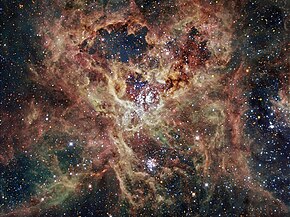| NGC 2070 | |
|---|---|
 NGC 2070 (ESO) NGC 2070 (ESO) Credit: ESO/IDA/Danish 1.5 m/R. Gendler, C. C. Thöne, C. Féron, and J.-E. Ovaldsen | |
| Observation data (J2000 epoch) | |
| Right ascension | 05 38 42 |
| Declination | −69° 06′ 00″ |
| Distance | 157 kly (48.5 kpc) |
| Apparent magnitude (V) | 7.25 |
| Apparent dimensions (V) | 3.50′ × 3.50′ |
| Physical characteristics | |
| Other designations | Caldwell 103, PKS 0539-69 |
| Associations | |
| Constellation | Dorado |
| See also: Open cluster, List of open clusters | |
NGC 2070 (also known as Caldwell 103) is a large open cluster and candidate super star cluster forming the heart of the bright region in the centre-south-east of the Large Magellanic Cloud. This cluster was discovered by French astronomer Nicolas-Louis de Lacaille in 1752. It is at the centre of the Tarantula Nebula and produces most of the energy that makes the latter's gas and dust visible. Its central condensation is the star cluster R136, one of the most energetic star clusters known. Among its stars are many of great dimension, including the second most massive star known, R136a1, at 215 M☉ and 6.16 million L☉.

References
- ^ "NGC 2070". SIMBAD. Centre de données astronomiques de Strasbourg. Retrieved 11 August 2017.
- Shapley, H.; Lindsay, E. M. (1963). "A Catalogue of Clusters in The LMC". Irish Astronomical Journal. 6: 74. Bibcode:1963IrAJ....6...74S.
- Jones, K. G. (March 1969). "The search for the nebulae - VI". Journal of the British Astronomical Association. 79: 213–222. Bibcode:1969JBAA...79..213J.
- Bosch, Guillermo; Terlevich, Elena; Terlevich, Roberto (2009). "Gemini/GMOS Search for Massive Binaries in the Ionizing Cluster of 30 Dor". Astronomical Journal. 137 (2): 3437–3441. arXiv:0811.4748. Bibcode:2009AJ....137.3437B. doi:10.1088/0004-6256/137/2/3437. S2CID 17976455.
External links
 Media related to NGC 2070 at Wikimedia Commons
Media related to NGC 2070 at Wikimedia Commons- "NGC 2070". SEDS Messier Database. 25 February 2008.